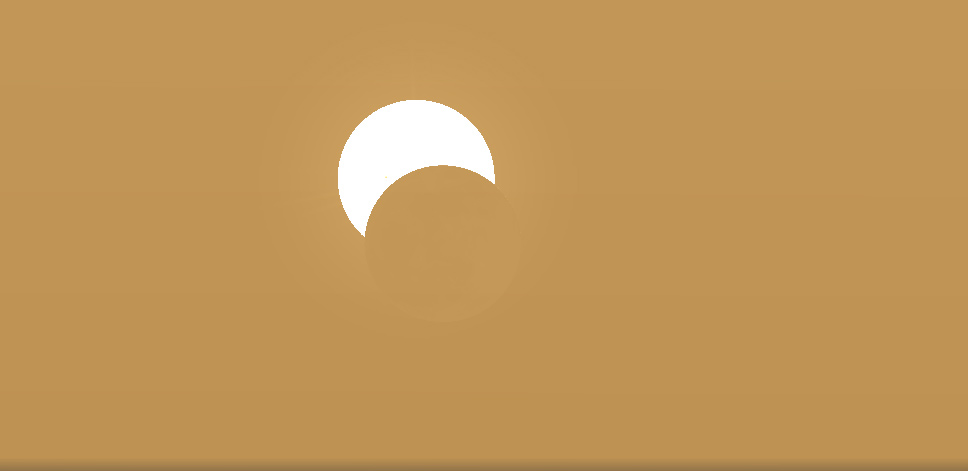
Partial Solar Eclipse & November Astronomical Highlights
November 2013 :
Note: This article may contain outdated information
This article was published in the November 2013 issue of The Skyscraper and likely contains some information that was pertinent only for that month. It is being provided here for historical reference only.
While we wait for Comet ISON to rendezvous with the Sun on Thanksgiving, there are only a couple of other astronomical events the casual stargazer may find interesting to observe during November. Please remember that EDT (Eastern Daylight Time) or DST (Daylight Saving Time) ends on the morning of November 3 at 2:00 a.m. when we fall back one hour to EST (Eastern Standard Time).
Venus will be very prominent in the southwest sky after sunset. Though it will still be fairly low in the sky, try to observe her cloud enshrouded disk as its phase illumination changes from 50 percent (appearing like a First Quarter Moon) on November 1 to just 31 percent (appearing like a waxing crescent Moon) on the 30th. On the 6th a beautiful sky scene will greet stargazers after sunset as the waxing crescent Moon passes above Venus.
From the eastern seaboard of the United States we will be treated to a partial solar eclipse at sunrise on the morning of November 3. The eclipse will already be in progress as the Sun rises above the horizon. Please refrain from monitoring this event without proper filters or alternative observing methods. Despite a large portion of the Sun being covered by the Moon, harmful visible and invisible radiation will cause irreparable eye damage.
Just because the sunlight may be dimmed by the dense atmosphere when the Sun is low on the horizon, do not stare at it. Sunglasses will not provide adequate protection from the Sun’s harmful rays. Number 14 welder’s glass is safe to use. DO NOT use exposed film of any kind. This method is not safe. In past columns on observing solar eclipses I have instructed folks on how to build a solar eclipse viewer using a shoe box. I’m not sure this observing method will work in this circumstance. With the Sun so low, the resulting image may not be bright enough to project a reasonable image.
Only if you are an experienced solar observer should you attempt to observe this partial eclipse with a properly filtered telescope or by using the solar projection method. If you have never observed the Sun before this event, don’t start now! Don’t risk your eyesight due to an oversight or an outright mistake. Even if you have one of those department store refractors that often come with small glass or plastic filters, do not be tempted to use them. They have been known to shatter when exposed to the Sun’s concentrated image.
Think about what a small magnifying glass can do, and then imagine the amount of energy a larger telescope can focus. It’s not worth it damaging your eyesight. Many years ago, when I first started out in astronomy, I had one of those glass/plastic filters shatter during a partial solar eclipse. Luckily I wasn’t looking through the eyepiece at the time.
If you use the Sun projection method (using a telescope to project the Sun’s image on a white screen), remember to be very cautious if other folks, especially children, are nearby. You don’t want anyone accidentally stepping up to an unguarded eyepiece to take a look. And regarding eyepieces, do not use cemented eyepieces. Use air-spaced ones. Eyepieces have been ruined when the cement has melted due to the heat produced by the concentrated sunlight collected by a telescope. Also, remember to cap off your finder scope. I have seen solar observers singe their hair or clothes by failing to do so!!
If you purchased some solar eclipse glasses for the transit of Venus last year, here’s your opportunity to put them to good use (considering clouds prevented many of us from observing that event). These glasses will provide a safe view of the Sun. Even when observing the Sun using these glasses, observe caution as well. Caution will be the keyword of the day. You will not wish to ruin your eyesight by looking at the event unfiltered, for there will be many more astronomical events for your eyes to experience and enjoy in the coming years.
See the accompanying diagrams for how the eclipse will appear at specific times.
You may be wondering about the annual Leonid meteor shower on the morning of the 17th. Though the spectacular peak rates of more than a decade ago have long since passed, we can still usually expect to see perhaps up to 20 blue or green bright meteors per hour these days. And because the Leonids hit our atmosphere nearly head-on at about 44 miles per second the display produces many fireballs, with about half of them leaving trains of dust which can persist for minutes. Unfortunately, the Full Moon on the same night will prevent most members of this shower from being observed.
If you do happen to spot a very bright meteor, to determine if it is a member of the Leonid shower all you have to do is note if the shooting star originated in the area of the sky in the constellation of Leo. That radiant point is in the Sickle (backwards question mark) asterism. Bright Regulus marks the period of that punctuation mark.
Keep your eyes to the skies, but remember to be cautious if you intend on viewing the partial solar eclipse.



